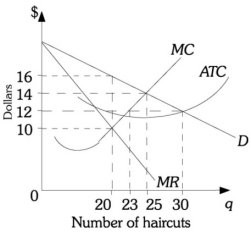Refer to the information provided in Figure 15.1 below to answer the question(s) that follow. Below are cost curves for Dom's Barber Shop, a monopolistically competitive firm.  Figure 15.1 Refer to Figure 15.1. If Dom's Barber Shop is maximizing profit, its total revenue equals
Figure 15.1 Refer to Figure 15.1. If Dom's Barber Shop is maximizing profit, its total revenue equals
A. $200.
B. $320.
C. $350.
D. $360.
Answer: B
You might also like to view...
Suppose Jack and Kate are at the town fair and are choosing which game to play. The first game has a bag with four marbles in it-1 red marble and 3 blue ones. The player draws one marble from the bag; if it is red, they win $20 and if it is blue, they win $1. The second game has a bag with 10 marbles in it-1 red, 4 blue, and 5 green. The player draws one marble from the bag; if it is red, they win $20; if it is blue, they win $5; and if it is green, they win $1. Both games cost $5 to play. The expected value of the payoff is _____ for the first game and _____ for the second game.
A. $5.00; $4.50 B. $5.75; $4.50 C. $4.50; $5.75 D. $5.75; $5.25
A natural monopolist's ability to price its product is
a. constrained by the market demand curve. b. constrained by market supply. c. not affected by market demand. d. enhanced by regulatory control of the government.
A taxpayer pays __________ tax rate on additional income if the income tax structure is progressive, __________ tax rate on additional income if the income tax structure is proportional, and __________ tax rate on additional income if the income tax structure is regressive
A) a higher; a lower; the same B) a higher; the same; a lower C) a lower; a higher; the same D) the same; a lower; a higher E) the same; a higher; a lower
The learning curve suggests that an individual will
A) receive the same income throughout a career. B) gain experience and increase productivity over time. C) be subject to frequent spells of unemployment. D) have an income that falls over time.